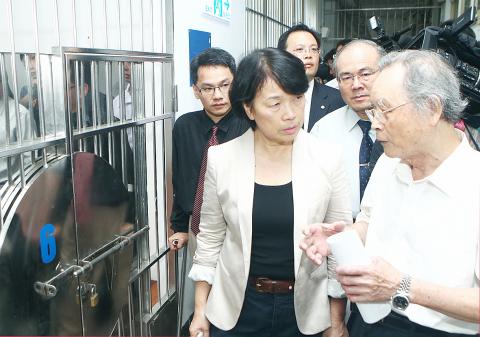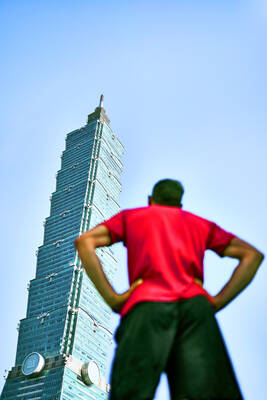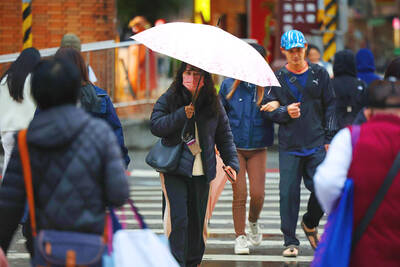The government is racing against time to preserve oral histories of survivors of the White Terror before they pass away, Minister of Culture Lung Ying-tai (龍應台) yesterday said at the Jingmei Human Rights Memorial and Cultural Park, where she met several former political prisoners, academics and human right activists and asked their advice on the National Human Rights Museum currently under preparation.
The planned museum includes a culture park in Jingmei, which once served as a military detention center where political dissidents were tried from the late 1960s to the 1980s, as well as a 32 hectare memorial park on Green Island (綠島) that was used to imprison prisoners of conscience.
A preparatory office was set up in December last year, and its current task is to collect, restore and manage documents and information relating to prisoners and victims from 1949, when martial law was declared in Taiwan until 1987, when it was lifted, government officials said.

Photo: Hu Shuan-shiang, Taipei Times
Former political prisoner Liu Chia-chin (劉佳欽) said that it was urgent to form a consultative committee so that different voices and suggestions could be heard and adopted by the museum. He also urged the government to focus its limited budget and resources on people and content rather than facilities.
To reach a larger number of people, former prisoner Chen Sung (陳松) suggested the museum recruit interested college and university students to do internships and volunteer work so that younger generations could learn about the nation’s past.
On the issue of oral history preservation, human rights activist Chen Ming-cheng (陳銘城) said that there was not enough time for museum staff to conduct one-on-one interviews with survivors, most of whom are in their 70s and 80s.
“We can do a lot more if local governments team up with local cultural and historical societies, as well as victim groups, to do the job,” Chen Ming-cheng said.
Academia Sinica research fellow Wu Nai-teh (吳乃德) echoed Chen Ming-cheng’s view, adding that it takes time to build trust between the government and victims’ families.
“It is difficult for the families to trust the government that once oppressed them. Donating personal objects and documents are just the beginning. The next step is to let the families know how their donations will be preserved, displayed and used. It’s another main task of the museum,” Wu said.
The researcher also said the National Archives should make public the classified files relating to political cases during the White Terror era. The access to original files has been limited even to family members seeking to understand what happened, Wu added.
Lung promised to negotiate with the National Archives on the matter, saying she was stunned when first learning that even now “it is difficult for family members to obtain letters left by their loved ones before they died.”
At yesterday’s meeting with Lung, Chen Meng-ho (陳孟和), who was jailed at Green Island’s New Life Correction Center for 15 years, donated an oil painting depicting what the island looked like during the White Terror era to the museum and invited Lung to pay a visit to Green Island, not as “an governmental official,” but as “a cultural worker.”
During his imprisonment, Cheng Meng-ho took photographs and created a number of sketches and drawings that were later used by the now-defunct Council for Cultural Affairs to reconstruct the prison.

US climber Alex Honnold is to attempt to scale Taipei 101 without a rope and harness in a live Netflix special on Jan. 24, the streaming platform announced on Wednesday. Accounting for the time difference, the two-hour broadcast of Honnold’s climb, called Skyscraper Live, is to air on Jan. 23 in the US, Netflix said in a statement. Honnold, 40, was the first person ever to free solo climb the 900m El Capitan rock formation in Yosemite National Park — a feat that was recorded and later made into the 2018 documentary film Free Solo. Netflix previewed Skyscraper Live in October, after videos

Starting on Jan. 1, YouBike riders must have insurance to use the service, and a six-month trial of NT$5 coupons under certain conditions would be implemented to balance bike shortages, a joint statement from transportation departments across Taipei, New Taipei City and Taoyuan announced yesterday. The rental bike system operator said that coupons would be offered to riders to rent bikes from full stations, for riders who take out an electric-assisted bike from a full station, and for riders who return a bike to an empty station. All riders with YouBike accounts are automatically eligible for the program, and each membership account

NUMBERS IMBALANCE: More than 4 million Taiwanese have visited China this year, while only about half a million Chinese have visited here Beijing has yet to respond to Taiwan’s requests for negotiation over matters related to the recovery of cross-strait tourism, the Tourism Administration said yesterday. Taiwan’s tourism authority issued the statement after Chinese-language daily the China Times reported yesterday that the government’s policy of banning group tours to China does not stop Taiwanese from visiting the country. As of October, more than 4.2 million had traveled to China this year, exceeding last year. Beijing estimated the number of Taiwanese tourists in China could reach 4.5 million this year. By contrast, only 500,000 Chinese tourists are expected in Taiwan, the report said. The report

Temperatures are forecast to drop steadily as a continental cold air mass moves across Taiwan, with some areas also likely to see heavy rainfall, the Central Weather Administration (CWA) said. From today through early tomorrow, a cold air mass would keep temperatures low across central and northern Taiwan, and the eastern half of Taiwan proper, with isolated brief showers forecast along Keelung’s north coast, Taipei and New Taipei City’s mountainous areas and eastern Taiwan, it said. Lows of 11°C to 15°C are forecast in central and northern Taiwan, Yilan County, and the outlying Kinmen and Lienchiang (Matsu) counties, and 14°C to 17°C